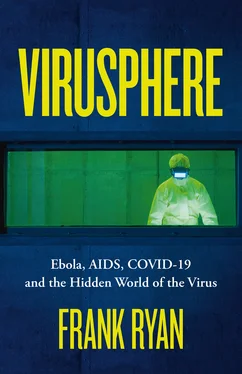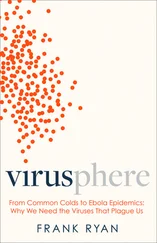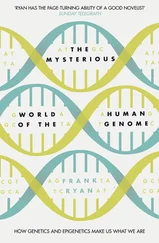Hankin probed the riddle further. He found that if he boiled the water before adding it to the cholera germ cultures this removed the bug-killing effect. This suggested that the agent that was killing the cholera germs was likely to be of a biological nature. He needed to know if it was another germ – sometimes germs antagonised one another – or if it was something completely different, a truly mysterious agent, that was killing the germs. Hankin decided that he would set up a new experiment using a device known as a Chamberland-Pasteur ‘germ-proof’ filter, which had been developed 12 years earlier by the French microbiologists Charles Chamberland and Louis Pasteur. The Chamberland-Pasteur filter was a flask-like apparatus made out of porcelain that allowed microbiologists to pass fluid extracts through a grid of pores varying from 0.1 to 1.0 microns in diameter – from 100-billionths to 1,000-billionths of a metre – that were designed to trap bacteria but allow anything smaller to pass through. Two years after the filter’s invention, a German microbiologist, Adolf Mayer, showed that a common disease of tobacco plants, known as tobacco mosaic disease, could be transmitted by a filtrate that had passed through the finest Chamberland-Pasteur filter. Unfortunately, he persuaded himself that the cause of the disease must somehow be a very tiny bacterium. In 1892 a Russian microbiologist, Dmitri Ivanovsky, repeated the experiment to get the same results. He refuted a bacterial cause, but still arrived at the mistaken conclusion that there must be a non-biological chemical toxin in the liquid extract. Finally, in 1896, the same year that Hankin was looking for his mystery agent in the Indian river waters, a Dutch microbiologist, Martinus Beijerinck, repeated the filter experiment with tobacco mosaic disease; but Beijerinck concluded that the causative agent was neither a bacterium nor a chemical toxin but rather ‘a contagious living fluid’. Although Beijerinck was closest of all to the truth, he was once again wrong. Today we know that the cause of tobacco mosaic disease is a virus – the tobacco mosaic virus. But thanks to Beijerinck’s mistaken finding of a ‘contagious fluid’, the current Oxford English Dictionary definition of a ‘virus’ has it as: ‘a poison, a slimy fluid, an offensive odour, or taste’.
Viruses are not poisons, or slimy fluids, or offensive odours or tastes, but rather organisms – truly remarkable organisms – that are different from bacteria, indeed utterly different from any other organisms on Earth. The great majority of viruses are very small, tiny enough to pass through Chamberland-Pasteur filters.
Of course, Hankin knew nothing of the existence of viruses when he passed the river water through the refined sieve of a Chamberland-Pasteur filter. Although he was in no position to offer a likely explanation or name for the mystery agent, he had discovered one of the most important and ubiquitous of viruses on Earth: a member of the group known today as ‘bacteriophage’ viruses, so-named from the Greek phagein , which means to devour. That is exactly what was happening to the cholera germs in Hankin’s experiments: they were being ‘devoured’ by bacteriophage viruses.
The true nature of Hankin’s discovery remained a mystery until 1915, when English bacteriologist Frederick Twort discovered a similarly minuscule agent that could pass through the Chamberland-Pasteur filters and yet remained capable of killing bacteria. By now viruses were known to exist even though biologists knew very little about them. Twort surmised that he was observing either a natural phase of the life cycle of the bacteria, the result of a fatal enzyme produced by the bacteria themselves, or a virus that grew on and destroyed the bacteria. Some two years later, a pioneering, self-taught, French-Canadian microbiologist, Félix d’Herelle, finally solved the mystery.
D’Herelle was born in the Canadian city of Montreal but considered himself a citizen of the world. Before becoming involved with viruses, he had already travelled widely, working in numerous American, Asian and African countries, to finally settle at the Pasteur Institute in Paris. At this time the discipline of microbiology was a fashionable scientific research endeavour and it was rapidly expanding its knowledge base. During his researches in Tunisia, d’Herelle had come across what was probably a virus infecting a bacterium that itself caused a lethal plague in locusts. Now working at the famous Institute, even as the First World War raged nearby, he took a particular interest in the grimy disease known as bacterial dysentery, which was killing soldiers in their muddy trenches.
Bacterial – as opposed to amoebic – dysentery is caused by a genus called Shigella , which is passed on from the infected individuals through faecal hand-to-mouth contagion. The resultant illness ranges from a mild gut upset to a severe form, with agonising griping spasms of the bowel accompanied by high fever, bloody diarrhoea and what doctors call ‘prostration’. In July and August 1915 there was an outbreak of haemorrhagic bacterial dysentery among a cavalry squadron of the French army, which was stalemated on the Franco-German front little more than 50 miles from Paris. The urgent microbiological investigation of the outbreak was assigned to d’Herelle. In the course of intensive investigation of the bugs responsible, he discovered ‘an invisible, antagonistic microbe of the dysentery bacillus’ that caused clear holes of dissolution in the otherwise opaquely uniform growth of dysentery bacteria on agar culture plates. Unlike his earlier colleagues, he had no hesitation in recognising the nature of what he had found. ‘In a flash I understood: what caused my clear spots was … a virus parasitic on the bacteria.’
D’Herelle’s hunch proved to be correct. Indeed, it would be d’Herelle who would give the virus the name we know it by today: he called it a ‘bacteriophage’. Then the French-Canadian microbiologist had an additional stroke of luck. When studying an unfortunate cavalryman suffering from severe dysentery, he performed repeated cultivations of a few drops of the patient’s bloody stools. As usual, he grew the dysentery bug on culture plates and passed a fluid extract through a Chamberland-Pasteur filter, thus obtaining a filtrate that could be tested for the presence of virus. Day after day, he tested the filtrate by adding it to fresh broth cultures of the dysentery bug in glass bottle containers. For three days the broth quickly turned turbid, confirming teeming growth of the dysentery bug. On the fourth day new broth cultures initially became turbid as usual, but when he incubated the same cultures for a second night he witnessed a dramatic change. In his words, ‘All the bacteria had vanished: they had dissolved away like sugar in water.’
D’Herelle deduced that what he was witnessing was the effects of a bacteriophage virus, which must also be present in the cavalryman’s gut – a bacteriophage virus that was capable of devouring the Shigella germ. But then he had an additional stroke of genius. What if the same thing was happening inside the infected patient? He dashed to the hospital to discover that during the night the cavalryman’s condition had greatly improved and he went on to make a full recovery. At this time bacterial infections, such as dysentery, typhoid fever, tuberculosis and the streptococcus, were a major cause of disease and death throughout the world. With no known antibiotics to treat infections, there was a desperate need for any form of therapy. His observations with the dysentery bug bacteriophage gave d’Herelle the idea that, perhaps, phage viruses might be cultivated with the express purpose of treating dangerous bacterial infections.
During the 1920s and 1930s, d’Herelle conducted extensive research into the medical applications of bacteriophages, introducing the concept of phage therapy for bacterial infections. This therapy saw widespread use in the former Soviet Republic of Georgia, and also the United States, continuing in use until the discovery of antibacterial drugs in the 1930s and 1940s. The use of drugs was much simpler to apply and proved dramatically effective, thus supplanting bacteriophage therapy. But this did not stop d’Herelle from continuing to study this marvellous if deadly entity that was so very tiny that it was completely invisible even to the most powerful light microscope, and yet appeared to be so powerful when it came into contact with its prey bacteria.
Читать дальше












